by GREG FOX
The Southport Taxi Driver Murder case from 1952 and subsequent trial was a sensation within the Sunshine State. It also provided a considerable impetus for the career of rising detective in charge, Frank Bischof. But should events surrounding Bischof’s investigation into taxi driver Athol McCowan’s killing now be questioned? And what about the conviction of the notorious Arthur “Slim” Halliday for murder?
“Justice is poisoned at the fount when police fabricate evidence. Bischof told a policeman named McMahon that police that were not prepared to fabricate were no use to him” – Evan Whitton in “The Hillbilly Dictator: Australia’s Police State” (1989).

Courtroom Like A Bargain Sale
On Tuesday the 9th of December 1952, locals and holidaymakers queued into Scarborough Street with great anticipation. These were scenes never before witnessed in the usually quiet coastal enclave. Regional newspapers reported that the rush when the door to the small courtroom opened was like that of “a bargain sale.” Some onlookers stumbled and nearly fell as they raced to get a seat in the public section. Interested observers in their hundreds stood ten deep and filled the doorways and verandas. Women outnumbered men. Many ladies wore shoulder-less frocks while most men wore casual-coloured shirts, singlets, trousers or shorts. A few were even without shoes. Fishermen on their way to the sparkling Broadwater stopped to listen in on the proceedings, leaning their rods against the court railing.
Mr AE George entered the Southport courtroom and took up his position at the high bench. The senior magistrate was quick to warn all in attendance to maintain absolute silence during these hearings. Directing a policeman at the back of the court, the judge exclaimed, “I don’t know who owns these children but please take them out.”
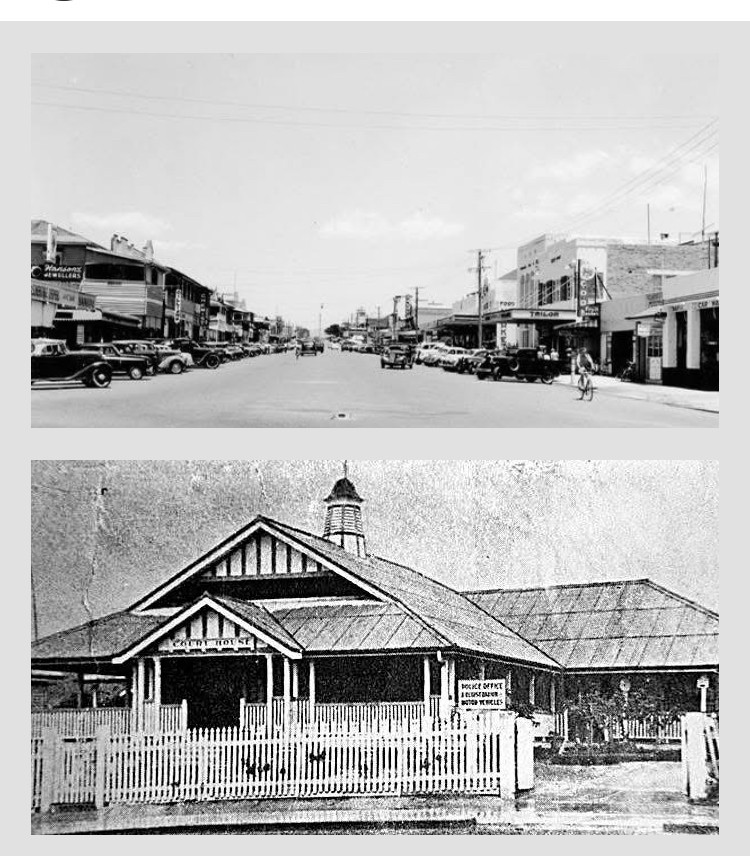
Now ready to commence, Mr George ordered the accused to stand. All eyes focused on the thin, weathered-looking man with distinct cheek bones. He wore glasses and was dressed in a somewhat ill-fitting grey suit with a white dress shirt unbuttoned at the neck. Arthur Ernest “Slim” Halliday aged 42 and a plumber of sorts from Brisbane would hear the charge that he wilfully murdered Athol Henry McCowan (24), a taxi driver from Southport. It was alleged that the killing occurred at Currumbin on the southern end of the south coast on the night of Thursday the 22nd of May. Halliday had been extradited to Queensland from Sydney, after initially being detained at Parramatta District Hospital in July. Special precautions had been made to remand the accused as police were concerned about attempts to escape custody.
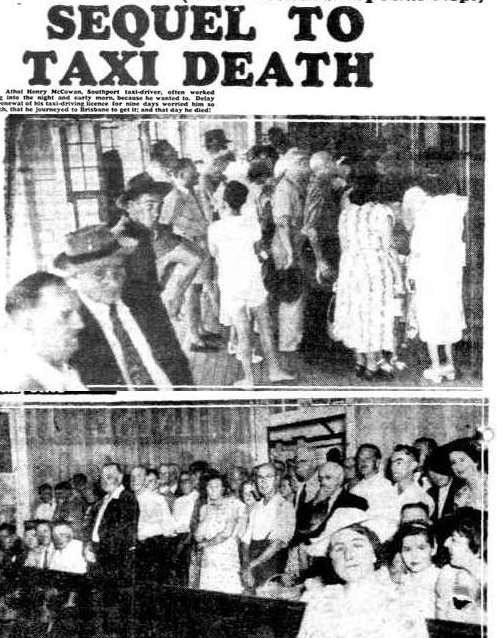
A Son With Sober Habits
The victim—Athol McCowan, from Queen Street in Southport—was the eldest of five children. He had enlisted in the Australian military in 1946 and served in Kure, Japan, near to Hiroshima, as an army driver with the British Commonwealth Occupational Force before being discharged in 1948. His father, Archibald McCowan, was the chef at St Hilda’s School in the town and described his son as “a quiet type, with sober habits, and no enemies”. Athol McCowan frequently worked long hours, mostly at night, for a Mr Ray “Max” Cameron, owner of Acme Taxis. Cameron owned two cabs: one black in colour and the other cream. McCowan usually drove the cream vehicle. He had been employed by the taxi business for the previous 12 months.
When asked about the victim, Cameron told the committal: “I do not know of any enemies McCowan may have had. I never found him unsatisfactory while he was driving for me. He was a very steady driver. He (McCowan) drove long hours of his own choice. Even though he was due for time off he would remain driving of his own accord. As far as I know he did not have a great deal of time for social life.”
This good-natured young man was known to help many of his infirm passengers in and out of his cab with a friendly smile and a kind word. The murder of the ex-serviceman had been a tragic circumstance. Since learning of McCowan’s demise an infused melancholy had enveloped the township.

McCowan was laid to rest in what was the largest funeral in Southport’s history. On the afternoon of Monday the 2nd of June, hundreds of mourners came together at St Andrew’s Presbyterian Church in Nerang Street to pay their respects, many weeping openly. Following the service, a procession of over 80 cars continued into Southport Cemetery at the western end of Queen Street for the burial. A special bus was used to carry many more to the graveside. Over 60 wreaths covered the coffin. Regrettably, McCowan’s mother was too ill to attend.
“Have I To Listen To this Persecution?”
There was a sensational start to the committal hearing as Detective Inspector Francis Erich Bischof addressed Mr George and presented the case. Bischof had been the lead detective in the McCowan investigation. His reputation as a brilliant investigator was built on an astonishing professional record. Before being appointed head of the Criminal Investigation Branch (CIB), Bischof had achieved a total of 32 guilty convictions in 33 homicide investigations.
Speaking to the court, Bischof got straight to the matter of a police interview in Sydney with Halliday from the past July. The accused was alleged to have told the detective: “I killed him” (speaking of McCowan’s murder).
With that, Halliday jumped to feet nimbly in the dock and screamed: “That’s a lie!”
The courtroom gasped, almost spellbound by the unfolding theatrics. The magistrate told the accused to stay seated and keep quiet.
Halliday retorted: “Have I to listen to this persecution?”
“Sit down and behave yourself,” an already exasperated Mr George returned.
It Happened Like This – Or Did It?
Detective Bischof outlined the confession to the court almost verbatim as provided by Halliday in Sydney, specifically, the police interviews at Parramatta District Hospital on the 5th and 6th of July. On those dates Halliday was being treated for a serious leg wound and fractured thigh bone. He would later be questioned at Central Police Station in the CBD on the 9th of November. Police suspected the accused had been using an alias for some time: Alfred Arthur Dale.

According to Bischof, this confession was also heard by Detective Sergeant Alfred Windsor of Sydney and Detective Sergeant William Hocken of Brisbane.
Halliday is alleged to have told the detectives: “It happened like this. I had to get dough and get it fast. The wife and I had a big bust up on the 20th of May. I looked like losing her for keeps. I went to Southport. I was desperate. I sweated around Southport the night it happened. I walked down past the Pacific Hotel and saw the cream Holden taxi pull up. I hopped in the front and asked him to drive me to Coolangatta in a hurry. When we got to the hill past Currumbin I to him to pull over on the side of the road. He pulled up near the seat near the look-out and I stuck a gun in his ribs and asked him to hand over the dough but he sort of jacked up and didn’t want to come into it.”
Bischof stated that during the police interview the accused went into the graphic details of his vicious killing of the taxi driver. Using the butt of a .45 calibre pistol Halliday struck McCowan with numerous devastating blows inside the cab, causing fatal head injuries. A post-mortem examination conducted by Dr Merrick O’Reilly, Deputy Director of the Microbiology and Pathology Laboratory from the State Health Department, concluded at least 13 strikes had been wielded on the young man by a hard instrument of some sort. The doctor confirmed the cause of death was a fractured skull and brain injury.
“I did his pockets and got his wallet,” the accused is alleged to have told the three detectives at his hospital bedside.
Bischoff said Halliday gleefully admitted the following as a justification for the killing: “You call it murder but it is a case of the strong feeding the weak. Taxi drivers are easy marks. Some of the bastards should be killed for the things they put over the public and the way they rob the public. Plenty have been knocked off before.”
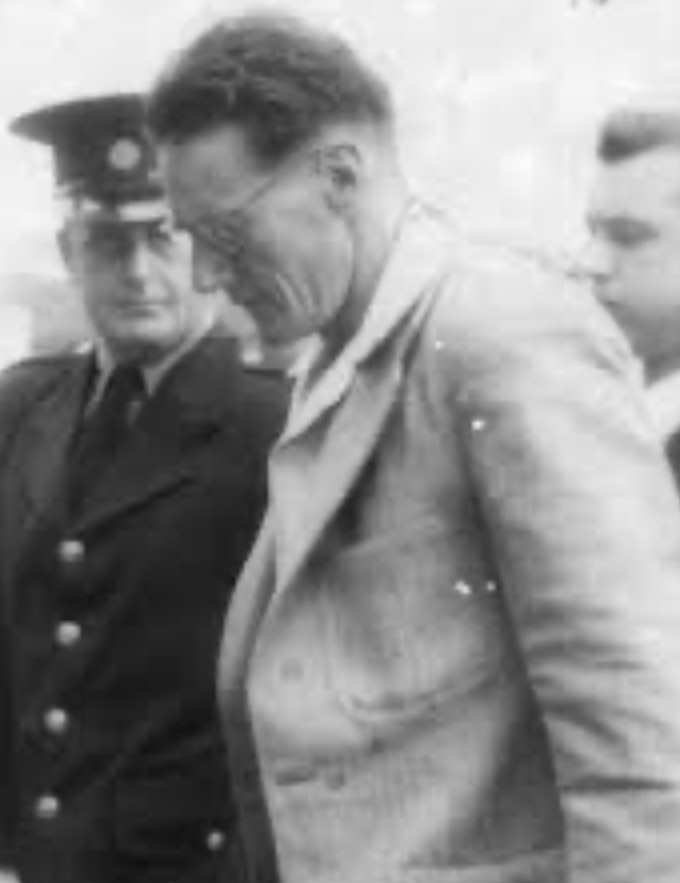
Source: The Courier Mail
Bischof alleged the accused then drove the taxi back to Currumbin Creek Bridge, stopped the vehicle and then pulled the now deceased McCowan from the backseat. Halliday proceeded to lift McCowan’s body over the railing into the creek below. He then drove north at speed to Southport and left the taxi at a grassed area on the Esplanade near Tuesley’s Jetty at around 10.30pm.
It was reported as an overcast and drizzly night on the south coast. People down at the Broadwater foreshore were few other than the odd angler. A local fisherman named Len Hollindale spotted the cream Holden taxi. Hollindale confirmed to police that at approximately 11.00pm he saw the abandoned vehicle parked near to the jetty but saw nothing suspicious taking place. The lights to the vehicle were switched off.
Questions Remain Over Currents
The body of Athol McCowan was found seven days later washed ashore at Serpentine Creek—near Cribb Island (where the Brisbane International Airport sits today)—by a shell grit worker named Leo Taylor. Speculation would persist for many years about the likelihood of the victim’s body floating all the way to Moreton Bay from the south coast. Many considered it not remotely possible.
The victim had at least 13 lacerations to his head including two fractures: one on top of the skull and another on the forehead. Notably the body had a large wound to his left thigh, likely caused by a shark bite. An Acme Taxis business card was found in his shirt pocket, but McCowan’s wallet and wristwatch were missing.
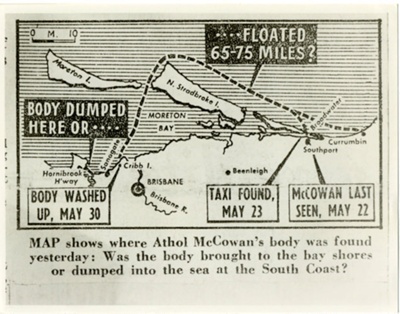
The police had prospector Mr Oliver Howden, of Rutile Sands Pty Ltd, give evidence about the likelihood of a body placed into the ocean at Currumbin being able to drift to Cribb Island, inside of Moreton Bay, seventy miles to the north. Mr Howden told the court of specific tests made with model floats in 1940 and 1942 to locate mineral sands deposits. The witness was unable to make a clear determination of the McCowan matter as he was unsure of Moreton Bay currents in May 1952. Mr Howden did say that if a buoyant object was put into Currumbin Creek on the night of the 22nd of May, prevailing winds and general currents would have seen an object drift in a northward direction. The prospector stated that two of his model floats from the test a decade ago, made of dressed pine (two feet long by three inches high with a lead keel), had drifted from Currumbin to as far north as Coolum and Dickie Beach on the Sunshine Coast.
Murdered For Two Quid?
Bischof, in his investigative summary to the hearing, continued providing specific details of Halliday’s supposed confession. He said the accused told him he got back into his white Commer utility truck at the Southport Esplanade after dumping the taxi. The truck was described as painted on the side: “A. Dale, Crump Street, Holland Park”. Quickly departing the south coast, the accused drove to the Logan River Bridge near Beenleigh. This is where Halliday told the detectives he had “a screw at (McCowan’s) wallet.”
“There were two oners in it. I had done him for two quid,” Halliday said matter of factly.
Bischoff claimed that Halliday told him he threw the wallet in the river (at Logan) and then commenced the long drive to Sydney. The detective did tell the court the accused refused to give a written statement to the events of the night of the 22nd of May. Bishop said he asked the accused why he killed the taxi driver for such a small amount of money.
Halliday is alleged to have responded: “I was desperate. There was only one thing to do and that was bowl him over. I’ve got no conscience. Don’t worry about that. Society might call it murder but not me. To me it’s survival of the fittest. Birds eat and are free. They don’t work. Why should we?”
Then Bischof stated Halliday was found in possession of a pistol when he was in Sydney. The detective then tendered the said pistol as evidence as the weapon used in the killing of McCowan. Sydney detectives later found the gun on the accused during the commission of another serious crime involving Halliday in June 1942. This Colt .45 calibre automatic pistol was branded “US – Army” and was a M1911A1 model. A combat sidepiece, this model was manufactured in 1941 as the US entered into WW2. Dr O’Reilly, the government pathologist, undertook an examination of the weapon and concluded that the magazine bottom plate of the pistol fit exactly to the indentations into McCowan’s skull.
Bischof went further to say there was human blood embedded into the parts of the pistol which would match to the deceased’s blood type. Also, a human hair matching McCowan’s was found stuck to the Colt’s magazine.

Source: The Courier Mail
Jack Up And Give It A Go
Detective Sergeant WL Hocken also gave evidence at the committal hearing and wholly corroborated the evidence that Detective Bischof had presented about the questioning of Halliday in Sydney. He would add an enlightening footnote to the court proceedings. Hocken stated that when he went to Sydney on the 13th of November to make the formal arrest of Halliday at the Central Police Station watchhouse and bring him back to Brisbane, Halliday asked him bluntly: “Why am I charged in the name of Halliday?”
Hocken replied: “That was the name (you are) known to police in Brisbane.”
The accused countered: “Tell Mr Bischof that I won’t be going anywhere with you fellows (in Brisbane). From now on I’m going to jack up and give it a go.”
In the accused’s defence, Halliday’s counsel Mr Ken Mitchell had the opportunity to cross‑examine Detective Bischof. The solicitor was direct in his questioning of the star investigator: “The first time you saw Halliday (at Parramatta Hospital on the 5th of July) he had a badly shattered thigh … a fractured thigh bone?”
Bischof: “Yes.”
Mitchell: “Do you know if he was given morphia?”
Bischof: “I know he had none prior to our interview.”
Mitchell: “I am putting it to you that he did not make the confession you say he did.”
Bischof: “I am stating he definitely made it!”
A Robbery Gone Wrong
Records state Halliday was an inpatient under armed guard at the Parramatta Hospital since the 29th of June. Police confirmed at around 8.30pm that evening the suspect had attempted to rob a store with a firearm on Woodville Road in Guildford. In the hold-up, Halliday, with his face partially covered, scuffled with shopkeeper, Mr Cyril Brooker. The gun was discharged three times, with the assailant apparently shooting himself accidentally in the upper right leg. Halliday ended up being pinned to the floor by Brooker.
The shopkeeper’s wife, who had witnessed the failed robbery, phoned the police. On arrival at the scene, Detective Sergeant Raymond Perry asked Halliday, who was still lying on the floor on his back, “where he got the gun from.” Halliday replied that he bought the pistol from a “joker” for five pounds about a week ago at Paddington. The detective placed the gun into evidence.

Source: Qld Police Museum
Halliday, known to Sydney police as “Alfred Arthur Dale” of Cronulla, was charged with intent to murder and assault while armed, in the botched hold-up. Therein Brooker was awarded the British Empire Medal for his courageous life and death struggle with the now infamous criminal. Booker attended the later Southport committal hearing and identified Halliday as the man who attempted to rob him. He went further to say that during the scuffle the accused struck him several times with the butt of the revolver to the top of his head, causing his scalp to split and blood to flow.
The Legend of “Houdini” Halliday
Under cross-examination at the committal hearing, Detective Bischof admitted he knew of Halliday and his criminal reputation prior to this case. The detective acknowledged the accused had been known to police in Brisbane as early as the mid-1930’s. Halliday was born at Parramatta in 1910 and spent some of his childhood growing up in a church orphanage in the southern capital. His parents were reportedly killed in a car accident when he was 12. As a young man he worked several menial jobs across New South Wales before appearing as a farm hand at Ferny Grove in Brisbane in 1935. Halliday quickly earned the ire of police out at Dirranbandi, arrested in April 1936 for writing dud cheques. In 1939, Halliday was sentenced to Boggo Road Gaol for five years on breaking and entering charges.
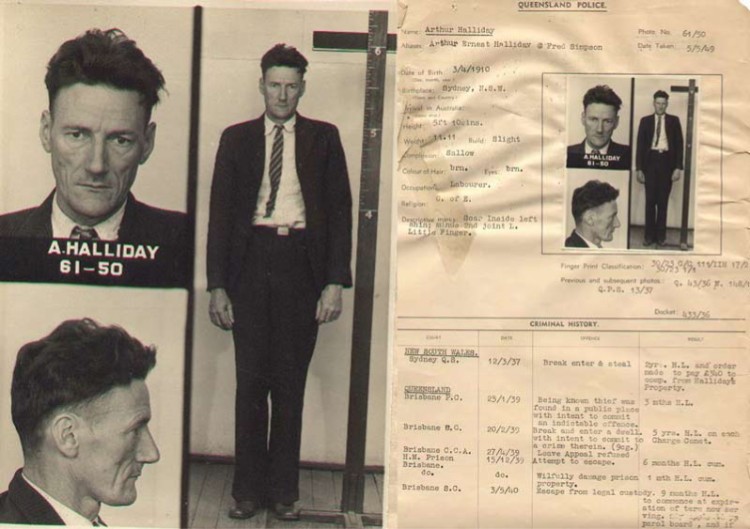
Whilst in gaol from the 20th of February 1939, he committed other offences which extended his incarceration. Those breaches included:
- wilful damage to prison property
- escaping from custody
- disorderly conduct within the prison
- assault of prison officers
- found in possession of a rope—likely to be used in an escape attempt
- gross insubordination to prison staff
- two attempted escapes from the gaol.
Halliday at varying times undertook hunger strikes. The prisoner was admitted to the Brisbane General Hospital—Ward 16 (the Psychiatric unit)—at least six times due to starvation.
Much of Slim Halliday’s notoriety was built around the escape attempts. By the time he had completed his sentence at the Dutton Park prison, Halliday would rank alongside Sydney-sider Darcy Dugan as one of the country’s most notorious escape artists.
Released from Boggo Road on the 1st of June 1949, he moved to Sydney before coming back to Brisbane to run a roof repair business. On the 2nd of January 1951, he married Irene Kathleen Close of Woolloongabba. They would have a tumultuous relationship. It’s around this time that Halliday began to use the alias of “Arthur Fred Dale”. This career criminal had, for the most part, gone straight since his release.
A Holden At Tuesley’s Jetty
Back at the committal hearing, Constable Noel Richard-Preston of Southport gave evidence that on Friday the 23rd of May he received a call to respond to Tuesley’s Jetty on the Esplanade. The policeman viewed a car—a cream Holden—parked on a grassy clearing near to the jetty, facing toward Pier Hill. Richard-Preston recognised it as an Acme Taxi owned by Max Cameron. But what he saw at the scene left the young copper genuinely unsettled.
Richard-Preston told the court: “I saw a large pool of blood on the floor in the front (of the taxi) … on the inside of the front doors were smears and spots of blood that extended towards the rear doors. On the inside of the windscreen were blood spots and smears as well.”
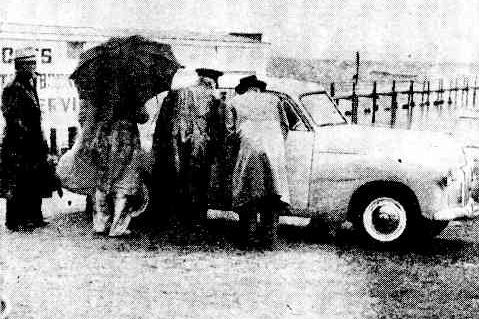
The constable’s testimony became even more gruesome as he described tufts of dark hair lying on the floor and what looked to be lumps of grey (brain) matter on the rear seat. The wires on the inside of the vehicle connecting to the electric taxi sign had been pulled out and were smeared with blood. This appeared to be evidence of a violent attack inside the taxi, but it was difficult to say without a victim or a body. No weapon of any sort was found inside the vehicle or near to what was now a potential crime scene. Investigators noted that the taxi’s speedometer had travelled 67 kilometres from the time McCowan took possession of the cab the previous evening.
The Accused’s Alibi
Halliday’s defence countered that he was indeed visiting Southport on the 20th of May but left the town that night (two days before McCowan’s murder) with “Peter”—his black and tan Alsatian cross—to head to Sydney to visit his brother George. The accused said it took about four days to make it to Sydney with many stops along the way including Goodna, Warwick, Tenterfield, Glen Innes, Uralla and Swansea. Halliday was adamant in his recollection on the stand. He was camped at Glen Innes on the evening of the 22nd of May, after picking up two soldiers that day at the border and thereafter dropping them into the town. After arriving in Sydney, Halliday sold his Commer utility at Christey’s Motor Auctions on Broadway for 425 pounds.
The Art of the Verbal
Halliday’s committal hearing lasted seven days. Almost unheard of at the time. The inquiry encompassed 60,000 words of testimony given by 47 witnesses. On the totality of this evidence the Senior Magistrate Mr George confirmed these matters must proceed to a full trial in Brisbane in the new year.
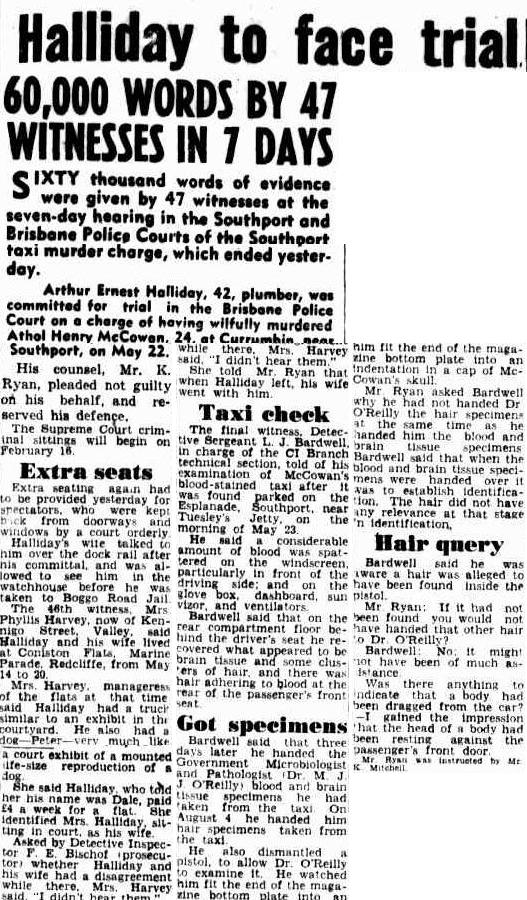
The crux of the crown case appeared damning: a “confession” from a down-on-his-luck, guilt-ridden, career criminal. Many believed Halliday’s fate sealed by his admissions, as heard from Bischoff. Add to that a mountain of circumstantial evidence within the investigators file, including eyewitness sightings of him (and his truck and dog) on the south coast around the time of the McCowan’s murder. Halliday’s freedom looked in real jeopardy.
But were these statements given by Bischof (and his fellow officers) a classic “verbal” (a verbal confession not supported by a written admissions) put on Halliday?
Was this “confession” from Halliday fabricated by police? Where one of the Queensland’s most decorated detectives manufactures a confession to implicate an undesirable patsy? At the time, no one was asking this question of the impeccably credentialled Detective Inspector Bischof.
PART 2: COMING SOON …
